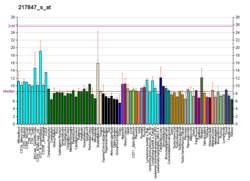THRAP3
Thyroid hormone receptor-associated protein 3 is a protein that in humans is encoded by the THRAP3 gene.[5]
References
Further reading
- Fondell JD, Ge H, Roeder RG (1996). "Ligand induction of a transcriptionally active thyroid hormone receptor coactivator complex". Proc. Natl. Acad. Sci. U.S.A. 93 (16): 8329–33. doi:10.1073/pnas.93.16.8329. PMC 38670. PMID 8710870.
- Ito M, Yuan CX, Malik S, et al. (1999). "Identity between TRAP and SMCC complexes indicates novel pathways for the function of nuclear receptors and diverse mammalian activators". Mol. Cell. 3 (3): 361–70. doi:10.1016/S1097-2765(00)80463-3. PMID 10198638.
- Rachez C, Lemon BD, Suldan Z, et al. (1999). "Ligand-dependent transcription activation by nuclear receptors requires the DRIP complex". Nature. 398 (6730): 824–8. doi:10.1038/19783. PMID 10235266.
- Näär AM, Beaurang PA, Zhou S, et al. (1999). "Composite co-activator ARC mediates chromatin-directed transcriptional activation". Nature. 398 (6730): 828–32. doi:10.1038/19789. PMID 10235267.
- Ge K, Guermah M, Yuan CX, et al. (2002). "Transcription coactivator TRAP220 is required for PPAR gamma 2-stimulated adipogenesis". Nature. 417 (6888): 563–7. doi:10.1038/417563a. PMID 12037571.
- Johnson KM, Wang J, Smallwood A, et al. (2002). "TFIID and human mediator coactivator complexes assemble cooperatively on promoter DNA". Genes Dev. 16 (14): 1852–63. doi:10.1101/gad.995702. PMC 186393. PMID 12130544.
- Wang Q, Sharma D, Ren Y, Fondell JD (2003). "A coregulatory role for the TRAP-mediator complex in androgen receptor-mediated gene expression". J. Biol. Chem. 277 (45): 42852–8. doi:10.1074/jbc.M206061200. PMID 12218053.
- Strausberg RL, Feingold EA, Grouse LH, et al. (2003). "Generation and initial analysis of more than 15,000 full-length human and mouse cDNA sequences". Proc. Natl. Acad. Sci. U.S.A. 99 (26): 16899–903. doi:10.1073/pnas.242603899. PMC 139241. PMID 12477932.
- Li J, Hawkins IC, Harvey CD, et al. (2003). "Regulation of Alternative Splicing by SRrp86 and Its Interacting Proteins". Mol. Cell. Biol. 23 (21): 7437–47. doi:10.1128/MCB.23.21.7437-7447.2003. PMC 207616. PMID 14559993.
- Brill LM, Salomon AR, Ficarro SB, et al. (2004). "Robust phosphoproteomic profiling of tyrosine phosphorylation sites from human T cells using immobilized metal affinity chromatography and tandem mass spectrometry". Anal. Chem. 76 (10): 2763–72. doi:10.1021/ac035352d. PMID 15144186.
- Beausoleil SA, Jedrychowski M, Schwartz D, et al. (2004). "Large-scale characterization of HeLa cell nuclear phosphoproteins". Proc. Natl. Acad. Sci. U.S.A. 101 (33): 12130–5. doi:10.1073/pnas.0404720101. PMC 514446. PMID 15302935.
- Jin J, Smith FD, Stark C, et al. (2004). "Proteomic, functional, and domain-based analysis of in vivo 14-3-3 binding proteins involved in cytoskeletal regulation and cellular organization". Curr. Biol. 14 (16): 1436–50. doi:10.1016/j.cub.2004.07.051. PMID 15324660.
- Gerhard DS, Wagner L, Feingold EA, et al. (2004). "The Status, Quality, and Expansion of the NIH Full-Length cDNA Project: The Mammalian Gene Collection (MGC)". Genome Res. 14 (10B): 2121–7. doi:10.1101/gr.2596504. PMC 528928. PMID 15489334.
- Nousiainen M, Silljé HH, Sauer G, et al. (2006). "Phosphoproteome analysis of the human mitotic spindle". Proc. Natl. Acad. Sci. U.S.A. 103 (14): 5391–6. doi:10.1073/pnas.0507066103. PMC 1459365. PMID 16565220.
- Gregory SG, Barlow KF, McLay KE, et al. (2006). "The DNA sequence and biological annotation of human chromosome 1". Nature. 441 (7091): 315–21. doi:10.1038/nature04727. PMID 16710414.
- Beausoleil SA, Villén J, Gerber SA, et al. (2006). "A probability-based approach for high-throughput protein phosphorylation analysis and site localization". Nat. Biotechnol. 24 (10): 1285–92. doi:10.1038/nbt1240. PMID 16964243.
- Olsen JV, Blagoev B, Gnad F, et al. (2006). "Global, in vivo, and site-specific phosphorylation dynamics in signaling networks". Cell. 127 (3): 635–48. doi:10.1016/j.cell.2006.09.026. PMID 17081983.
- Ewing RM, Chu P, Elisma F, et al. (2007). "Large-scale mapping of human protein–protein interactions by mass spectrometry". Mol. Syst. Biol. 3 (1): 89. doi:10.1038/msb4100134. PMC 1847948. PMID 17353931.
This article is issued from
Wikipedia.
The text is licensed under Creative Commons - Attribution - Sharealike.
Additional terms may apply for the media files.




